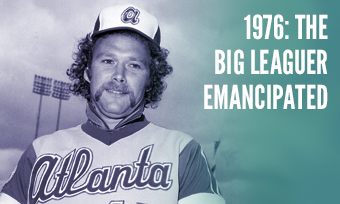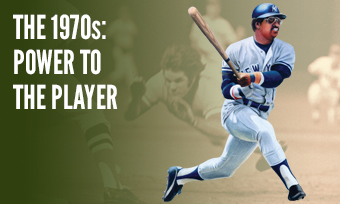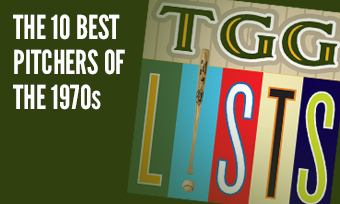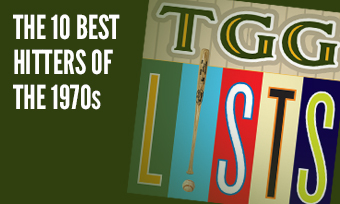The Yearly Reader
Leaders and Honors, 1976
Our list of baseball’s top 10 hitters and pitchers in both the American League and National League for the 1976 baseball season, as well as the awards and honors given to the game’s top achievers of the year.
The National League’s Top 10 Hitters, 1976
Bold type in brick red indicates league leader.
1. Joe Morgan, Cincinnati
Key Numbers: .320 average, 113 runs, 30 doubles, 5 triples, 27 home runs, 111 RBIs, 114 walks, 60 stolen bases, 12 sacrifice flies, .444 on-base percentage, .576 slugging percentage.
For the second straight year, Morgan excelled at everything, powering up to set career highs in home runs and RBIs.
2. Mike Schmidt, Philadelphia
Key Numbers: .262 average, 112 runs, 31 doubles, 38 home runs, 107 RBIs, 100 walks, 149 strikeouts, 11 hit-by-pitches, 14 stolen bases.
Schmidt set the tone for a third straight year leading the NL in home runs by smacking four at Chicago on April 17.
3. George Foster, Cincinnati
Key Numbers: .306 average, 86 runs, 172 hits, 21 doubles, 9 triples, 29 home runs, 121 RBIs, 17 stolen bases.
Given how incredible Morgan was, it seemed even more stunning that Foster—who took eight years to evolve into peak form—snared five first-place MVP votes from him.
4. Ken Griffey, Cincinnati
Key Numbers: .336 average, 111 runs, 189 hits, 28 doubles, 9 triples, 6 home runs, 74 RBIs, 34 stolen bases.
A perennial .300 hitter, the young Griffey had his absolute best shot at winning a batting crown when, ahead of Bill Madlock by five points going into the season’s final day, he sat out to play it safe. It wasn’t safe enough; Madlock went 4-for-4 to grab the title.
5. Pete Rose, Cincinnati
Key Numbers: 162 games, .323 average, 665 at-bats, 130 runs, 215 hits, 42 doubles, 6 triples, 10 home runs, 63 RBIs, 86 walks.
The fact that four Cincinnati players take up the top five slots on this list tells you just how oppressive the Big Red Machine was in 1976. Rose led the NL in both runs and doubles for the third straight year.
6. Cesar Cedeno, Houston
Key Numbers: .297 average, 89 runs, 171 hits, 26 doubles, 5 triples, 18 home runs, 83 RBIs, 58 stolen bases.
Astonishing numbers for Cedeno, given how badly beaten up his knees and ankles had become. For the second time in his career, he hit for the cycle.
7. Rick Monday, Chicago
Key Numbers: 137 games, .272 average, 107 runs, 20 doubles, 5 triples, 32 home runs, 77 RBIs.
The very first pick in the very first amateur draft 10 years earlier, Monday went from good to very good in the Cubs’ lineup, performing the then-rare feat of hitting 30 homers from the leadoff spot. Oh, and he also saved the American flag.
8. Bill Madlock, Chicago
Key Numbers: .339 average, 68 runs, 174 hits, 36 doubles, 15 home runs, 84 RBIs, 11 hit-by-pitches, 15 stolen bases.
Madlock won his second straight NL batting crown, but how does a .339 hitter score just 68 runs? (Answer: He plays for the Cubs.)
9. Bob Watson, Houston
Key Numbers: .313 average, 76 runs, 183 hits, 31 doubles, 16 home runs, 102 RBIs.
The ever-consistent, ever-effective Watson continued to be Houston’s Mechanical Man.
10. Dave Parker, Pittsburgh
Key Numbers: 138 games, .313 average, 82 runs, 168 hits, 28 doubles, 10 triples, 13 home runs, 90 RBIs, 19 stolen bases.
The Cobra suffered through a mild power outage, but his month-to-month parabolic swings were even more of a head scratcher; in May, July and September/October, he hit .374—while in April, June and August, his average was checked in at an even .250.
The American League’s Top 10 Hitters, 1976
1. Rod Carew, Minnesota
Key Numbers: .331 average, 97 runs, 200 hits, 29 doubles, 12 triples, 9 home runs, 90 RBIs, 49 stolen bases.
Lost in the AL batting race’s season-ending controversy between Hal McRae and George Brett (see below) was that Carew himself nearly interjected himself into the storyline on the same field, finishing just two points off the top; it would be the only time between 1971-79 that he would fail to win a batting title.
2. Hal McRae, Kansas City
Key Numbers: .332 average, 175 hits, 34 doubles, 5 triples, 8 home runs, 73 RBIs, 22 stolen bases, .407 on-base percentage.
McRae fumed over the Twins “allowing” George Brett’s short fly to drop for a hit in his last at-bat to win the batting title by a point—but McRae had it in the bag, batting .358 as late as August 27, before it was brought down at season’s end.
3. Mickey Rivers, New York
Key Numbers: .312 average, 95 runs, 184 hits, 31 doubles, 8 triples, 8 home runs, 67 RBIs, 13 walks, 43 stolen bases.
Rivers’ speedy presence, negligence of the walk—he only drew 13 in 614 plate appearances—and fine contact hitting made the Yankees’ trade to get him (and pitcher Ed Figueroa, no less) from Anaheim for one-and-done Bobby Bonds a steal of a deal.
4. Reggie Jackson, Baltimore
Key Numbers: 134 games, .277 average, 84 runs, 27 doubles, 27 home runs, 91 RBIs, 28 stolen bases, .502 slugging percentage.
Wedged in between tumultuous tours of duty in Oakland and New York, Reggie Jackson lived relative peace and tranquility in a brief one-year stay at Baltimore—but only after a slow (.222 average on July 2) and belated (first game played on May 2) debut.
5. George Brett, Kansas City
Key Numbers: .333 average, 645 at-bats, 94 runs, 215 hits, 34 doubles, 14 triples, 7 home runs, 67 RBIs, 21 stolen bases.
Brett’s batting title was his first of three; each came in a different decade. He also finished second in the AL MVP vote behind Yankees catcher Thurman Munson.
6. Roy White, New York
Key Numbers: .286 average, 104 runs, 179 hits, 29 doubles, 14 home runs, 65 RBIs, 83 walks, 31 stolen bases.
After suffering through every single year of the Yankees’ CBS era, White finally got to taste the postseason thanks in part to his own efforts.
7. Dan Ford, Minnesota
Key Numbers: .267 average, 87 runs, 24 doubles, 7 triples, 20 home runs, 86 RBIs, 10 hit-by-pitches, 17 stolen bases.
Ford’s numbers matched the flash that came with all the bling he wore—leading to his nickname, “Disco Dan.”
8. Amos Otis, Kansas City
Key Numbers: .279 average, 93 runs, 40 doubles, 18 home runs, 86 RBIs, 26 stolen bases.
The veteran outfielder unexpectedly became the Royals’ prime power source as John Mayberry suffered a brownout at the plate; his leverage to the postseason was crucially short-lived as he sprained his ankle in the first inning of ALCS Game One and missed the rest of the series’ defeat to the Yankees.
9. Rusty Staub, Detroit
Key Numbers: 161 games, .299 average, 176 hits, 28 doubles, 15 home runs, 96 RBIs, 83 walks, 23 grounded into double plays.
After being all but idolized in Montreal and New York with the Mets, Detroit became the latest stop for Staub to win over the fans.
10. Graig Nettles, New York
Key Numbers: .254 average, 88 runs, 29 doubles, 32 home runs, 93 RBIs, 11 stolen bases.
The Yankees’ hitting star for the moment—becoming the first Yankee to lead the AL in home runs since Roger Maris in 1961—Nettles would later say: “When I was a little boy, I wanted to be a baseball player and join the circus. With the Yankees, I’ve accomplished both.”
The National League’s Top 10 Pitchers, 1976
1. Randy Jones, San Diego
Key Numbers: 2.74 ERA, 22 wins, 14 losses, 40 starts, 25 complete games, 315.1 innings, 50 walks, 34 grounded into double plays.
Jones’ fleeting reign as a top NL pitcher peaked with a Cy Young Award performance. Some would argue that it should have been his second such honor in as many years.
2. Jerry Koosman, New York
Key Numbers: 2.69 ERA, 21 wins, 10 losses, .677 win percentage, 32 starts, 247.1 innings.
Koosman snuck in his only 20-win effort as a Met just as dark times began to loom over Shea Stadium.
3. Tom Seaver, New York
Key Numbers: 2.59 ERA, 14 wins, 11 losses, 34 starts, 271 innings, 235 strikeouts, 12 wild pitches, 26 stolen bases allowed.
Despite a marginal record fueled by a lack of offensive gas from teammates, Seaver won his fifth (and last) strikeout crown—and began to presage the end of his Mets tenure by deepening a feud with team owner M. Donald Grant and his poison pen buddy, the New York Daily News’ Dick Young, over the club’s reluctance to spend on free agents.
4. J.R. Richard, Houston
Key Numbers: 2.75 ERA, 20 wins, 15 losses, 39 starts, 291 innings, 151 walks, 214 strikeouts, 13 wild pitches, 34 stolen bases allowed, 26 grounded into double plays.
Wild but nevertheless efficient, Richard emerged as the Astros’ new ace—becoming only the second Astro (after Larry Dierker, in 1969) to win 20 games. He had to win each of his last three starts to get there.
5. John Denny, St. Louis
Key Numbers: 2.52 ERA, 11 wins, 9 losses, 30 starts, 207 innings, 26 grounded into double plays.
Amid a punchless (63 team homers) and aceless team that produced its worst record in 21 years, the second-year Denny gave Cardinals fans something to smile about by clinching the NL ERA title in his last start of the year.
6. Don Sutton, Los Angeles
Key Numbers: 3.06 ERA, 21 wins, 10 losses, .677 win percentage, 34 starts, 267.2 innings, 25 stolen bases allowed.
No 300-game winner won 20 in a season less than Sutton, who took down his one and only score in 1976.
7. Steve Carlton, Philadelphia
Key Numbers: 3.13 ERA, 20 wins, 7 losses, .741 win percentage, 35 starts, 252.2 innings, 28 stolen bases allowed.
After three subpar years, Carlton got his Mojo back thanks to a reunion with ex-Cardinals battery mate Tim McCarver.
8. Pat Zachry, Cincinnati
Key Numbers: 1.66 ERA, 13 wins, 3 losses, .813 win percentage, 22 saves, 6 blown saves, 65 appearances, 97.1 innings.
The 24-year-old right-hander saved his best for first, enjoying his finest season over a 10-year career while becoming co-NL Rookie of the Year with San Diego’s Butch Metzger.
9. Jon Matlack, New York
Key Numbers: 2.95 ERA, 17 wins, 10 losses, 35 starts, 6 shutouts, 262 innings, 57 walks, 23 grounded into double plays.
Like Tom Seaver, Matlack’s time with Mets was nearing an end; after a dreadful 1977 campaign pretty much in sync with Mets’ misfortunes, he was dealt to Texas.
10. John Candelaria, Pittsburgh
Key Numbers: 3.15 ERA, 16 wins, 7 losses, .696 win percentage, 1 save, 31 starts, 220 innings.
The young Pirates pitcher enjoyed a prime-time moment in the national spotlight when he threw his lone career no-hitter against the Dodgers on a midsummer episode of ABC’s Monday Night Baseball.
The American League’s Top 10 Pitchers, 1976
1. Vida Blue, Oakland
Key Numbers: 2.35 ERA, 18 wins, 13 losses, 37 starts, 6 shutouts, 298.1 innings, 63 walks.
True Blue had a superb season in which he cut down on the walks and opposing muscle (only nine home runs allowed) while capturing his best ERA since his spectacular 1971 debut. All that was missing was an abundant supply of wins, as poor support kept him from easily collecting 20.
2. Mark Fidrych, Detroit
Key Numbers: 2.34 ERA, 19 wins, 9 losses, .679 win percentage, 31 appearances, 29 starts, 24 complete games, 250.1 innings, 53 walks, 16 caught stealing/picked off, 25 grounded into double plays.
The Tigers milked the Fidrych phenomenon as financially as possible, making sure he pitched most of his games at Tiger Stadium; the team averaged 33,649 fans in his 18 home starts, and 10,677 in their other 62 games at The Corner.
3. Frank Tanana, California
Key Numbers: 2.43 ERA, 19 wins, 10 losses, 34 starts, 23 complete games, 288.1 innings, 261 strikeouts, 34 stolen bases allowed, 22 caught stealing/picked off.
Still very much Nolan Ryan’s equal (if not better) at Anaheim Stadium, Tanana arguably pitched the year’s most impressive game when he threw 13 shutout innings against the Yankees on August 27 before departing a 0-0 game.
4. Jim Palmer, Baltimore
Key Numbers: 2.51 ERA, 22 wins, 13 losses, 40 starts, 23 complete games, 6 shutouts, 315 innings, 33 stolen bases allowed.
In winning his second straight Cy Young Award, Palmer dared the splits to defy any inconsistency, because there was none; he was equally good at home and on the road, against right-handers and left-handers, day and night, month of the year, etc., etc., etc.
5. Mike Torrez, Oakland
Key Numbers: 2.50 ERA, 16 wins, 12 losses, 39 starts, 266.1 innings, 30 grounded into double plays.
Suddenly finding himself in Oakland after being part of a huge trade that sent he and Don Baylor to the A’s for Reggie Jackson and Ken Holtzman, Torrez quickly readjusted and produced a career-low ERA—all with the help of a streak of 38.1 consecutive scoreless innings, easily the year’s best.
6. Ken Brett, New York-Chicago
Key Numbers: 3.28 ERA, 10 wins, 12 losses, 1 save, 26 starts, 200.2 innings.
Shipped to Chicago before he had a chance to settle in at New York—the Pirates dealt him there during the offseason—the older brother of George Brett pitched at his best but was handicapped by the DH rule that didn’t allow him to hit. That’s a shame, given he was pretty good at it (.262 average, 10 homers in 347 career at-bats).
7. Paul Hartzell, California
Key Numbers: 2.77 ERA, 7 wins, 4 losses, 2 saves, 37 appearances, 15 starts, 166 innings, 43 walks, 10 hit-by-pitches, 25 grounded into double plays.
The rookie right-hander was a good reliever to start the year and an even better starter to finish it, making for late chatter in the AL ERA conversation.
8. Luis Tiant, Boston
Key Numbers: 3.06 ERA, 21 wins, 12 losses, 38 starts, 279 innings, 16 caught stealing/picked off, 21 grounded into double plays.
Tiant had one of the stranger lines on May 8 against Texas when he allowed nine runs—all unearned—in just 1.2 innings of work.
9. Wayne Garland, Baltimore
Key Numbers: 2.67 ERA, 20 wins, 7 losses, .741 win percentage, 1 save, 38 appearances, 25 starts, 232.1 innings, 27 stolen bases allowed.
Garland won 20 games at just the right time; he’d be rewarded by Cleveland with a fat contract and become the game’s first celebrated free agent bust.
10. Ed Figueroa, New York
Key Numbers: 3.02 ERA, 19 wins, 10 losses, 34 starts, 256.2 innings, 94 walks, 16 caught stealing/picked off.
A year after toiling for the anemic Angels, Figueroa was happy to pitch for a team that actually scored runs.









